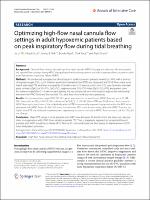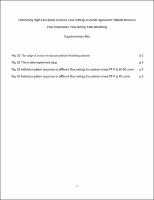| dc.contributor | Vall d'Hebron Barcelona Hospital Campus |
| dc.contributor.author | Li, Jie |
| dc.contributor.author | Brady Scott, J. |
| dc.contributor.author | Fink, James B. |
| dc.contributor.author | Reed, Brooke |
| dc.contributor.author | Roca Gas, Oriol |
| dc.contributor.author | Dhand, Rajiv |
| dc.date.accessioned | 2022-05-16T12:13:48Z |
| dc.date.available | 2022-05-16T12:13:48Z |
| dc.date.issued | 2021-11-27 |
| dc.identifier.citation | Li J, Brady Scott J, Fink JB, Reed B, Roca O, Dhand R. Optimizing high-flow nasal cannula flow settings in adult hypoxemic patients based on peak inspiratory flow during tidal breathing. Ann Intensive Care. 2021 Nov 27;11:164. |
| dc.identifier.issn | 2110-5820 |
| dc.identifier.uri | https://hdl.handle.net/11351/7534 |
| dc.description | High-flow nasal cannula; Hypoxemia; Peak inspiratory flow |
| dc.description.abstract | Background
Optimal flow settings during high-flow nasal cannula (HFNC) therapy are unknown. We investigated the optimal flow settings during HFNC therapy based on breathing pattern and tidal inspiratory flows in patients with acute hypoxemic respiratory failure (AHRF).
Methods
We conducted a prospective clinical study in adult hypoxemic patients treated by HFNC with a fraction of inspired oxygen (FIO2) ≥ 0.4. Patient’s peak tidal inspiratory flow (PTIF) was measured and HFNC flows were set to match individual PTIF and then increased by 10 L/min every 5–10 min up to 60 L/min. FIO2 was titrated to maintain pulse oximetry (SpO2) of 90–97%. SpO2/FIO2, respiratory rate (RR), ROX index [(SpO2/FIO2)/RR], and patient comfort were recorded after 5–10 min on each setting. We also conducted an in vitro study to explore the relationship between the HFNC flows and the tracheal FIO2, peak inspiratory and expiratory pressures.
Results
Forty-nine patients aged 58.0 (SD 14.1) years were enrolled. At enrollment, HFNC flow was set at 45 (38, 50) L/min, with an FIO2 at 0.62 (0.16) to obtain an SpO2/FIO2 of 160 (40). Mean PTIF was 34 (9) L/min. An increase in HFNC flows up to two times of the individual patient’s PTIF, incrementally improved oxygenation but the ROX index plateaued with HFNC flows of 1.34–1.67 times the individual PTIF. In the in vitro study, when the HFNC flow was set higher than PTIF, tracheal peak inspiratory and expiratory pressures increased as HFNC flow increased but the FIO2 did not change.
Conclusion
Mean PTIF values in most patients with AHRF were between 30 and 40 L/min. We observed improvement in oxygenation with HFNC flows set above patient PTIF. Thus, a pragmatic approach to set optimal flows in patients with AHRF would be to initiate HFNC flow at 40 L/min and titrate the flow based on improvement in ROX index and patient tolerance. |
| dc.language.iso | eng |
| dc.publisher | Springer |
| dc.relation.ispartofseries | Annals of Intensive Care;11 |
| dc.rights | Attribution 4.0 International |
| dc.rights.uri | http://creativecommons.org/licenses/by/4.0/ |
| dc.source | Scientia |
| dc.subject | Oxigenoteràpia |
| dc.subject | Anoxèmia - Tractament |
| dc.subject | Medicina intensiva |
| dc.subject.mesh | Hypoxia |
| dc.subject.mesh | /therapy |
| dc.subject.mesh | Oxygen Inhalation Therapy |
| dc.subject.mesh | Critical Care |
| dc.title | Optimizing high-flow nasal cannula flow settings in adult hypoxemic patients based on peak inspiratory flow during tidal breathing |
| dc.type | info:eu-repo/semantics/article |
| dc.identifier.doi | 10.1186/s13613-021-00949-8 |
| dc.subject.decs | hipoxia |
| dc.subject.decs | /terapia |
| dc.subject.decs | tratamiento por inhalación de oxígeno |
| dc.subject.decs | asistencia del enfermo crítico |
| dc.relation.publishversion | https://doi.org/10.1186/s13613-021-00949-8 |
| dc.type.version | info:eu-repo/semantics/publishedVersion |
| dc.audience | Professionals |
| dc.contributor.organismes | Institut Català de la Salut |
| dc.contributor.authoraffiliation | [Li J, Scott JB, Reed B] Division of Respiratory Care, Department of Cardiopulmonary Sciences, Rush University, 600 S Paulina St, Suite 765, Chicago, IL 60612, USA. [Fink JB] Division of Respiratory Care, Department of Cardiopulmonary Sciences, Rush University, 600 S Paulina St, Suite 765, Chicago, IL 60612, USA. Aerogen Pharma Corp, San Mateo, CA, USA. [Roca O] Servei de Medicina Intensiva, Vall d’Hebron Hospital Universitari, Barcelona, Spain. Ciber Enfermedades Respiratorias (Ciberes), Instituto de Salud Carlos III, Madrid, Spain. [Dhand R] Division of Pulmonary and Critical Care Medicine, Department of Medicine, University of Tennessee Graduate School of Medicine, Knoxville, TN, USA |
| dc.identifier.pmid | 34837553 |
| dc.identifier.wos | 000722998200001 |
| dc.rights.accessrights | info:eu-repo/semantics/openAccess |


